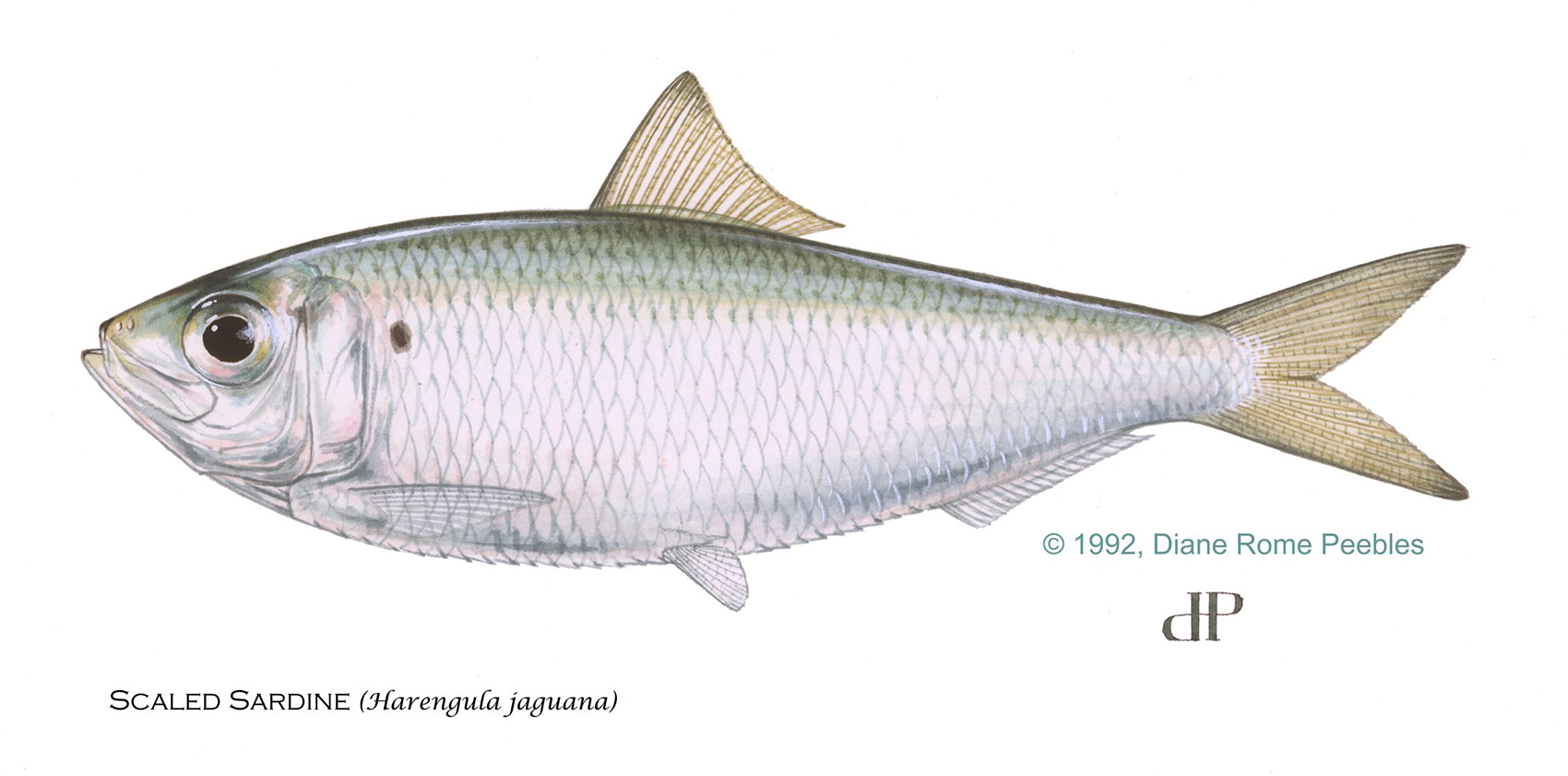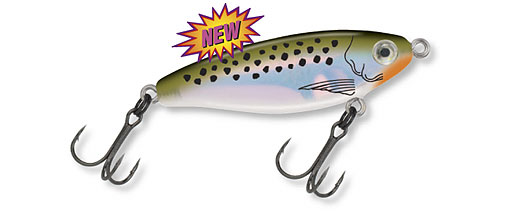Neil Taylor, Strike Three Kayak Fishing and Capmel.com
Known by many names: Greenbacks, LY’s, whitebait and others- the scaled sardine is one of the preferred baitfish in the ecosystem. At the right time of year you can expect them to be around and available. Catching them is “throwing the net.” Aid in catching them: Jack mackerel, chummed into an area draws them in to make them easier to castnet. Chumming bait is a good way to get more bait faster. The jack mackerel is in most grocery stores.
The Spanish sardine, long and skinnier: Not as durable but a quality bait. The standard scaled sardine is a little more football shaped and stays alive better. They are better than threadfins. They are way better than glass minnows. Threadfins and glass minnows are a bait choice but they are inferior to the scaled sardine.
“Dead or alive”, the sardine work fresh dead if not used as a live bait. Great for snapper, they will be eaten by a wide variety of species. If I had to choose, I’d use them live over dead but a dead sardine will catch fish.
The grassflats, four to seven feet deep, the schools of sardines will gather. Bubbled on the surface they are easy to spot and catch for bait. “Stickers” are juvenile sardines that stick in the net mesh. You don’t want to throw your net over these smaller baits. You want the ones that are 3 inches long. A search, you should find the right bait.
I am “all lures all the time.” Back in the day, I used live bait. Mostly, I had sardines I’d catch with my small six foot net with a small mesh. Lure designers for Florida fishing usually make lures in colors that mimic the scaled sardine. A greenish top and a white belly, that is my favorite choice in Mirrolures (called “18”).
Keep them alive: Aerators for cutoff water holding tanks. Bait buckets keep them alive. Taking five gallon buckets and drilling 100 holes in them and getting a snap lid is a great way to contain sardines alive and keep them alive. Attach a rope to the bucket and you can also put a section of pool noodle around the rim of the top of the bucket.
If I ever use live bait again: It’s sardines and it’s likely I’m in Port St Joe, in the Panhandle. I’ll bait a hook there. Flounder and trout galore. Never did that well on lures there. I’ve tried. It is an example of “live bait is necessary.”
They are not hard to find and catch. West coast and Panhandle, better than Atlantic, they are the bait of choice if they are there for you to use.
Wikipedia:The scaled sardine, Harengula jaguana, is a herring-like fish in the family Clupeidae. It is native to coastal waters of the western Atlantic Ocean, from the Gulf of Mexico (where it is known as the pilchard or whitebait) down to Brazil where it is called mata.It has a solid back with dark streaks and usually a small dark spot at the upper edge of the operculum and sometimes one located at the shoulder. It grows up to 9 inches (23 cm) in length but typically is little more than half that size.It is a fast-growing species, living only 12 to 18 months.Scaled sardines are often referred to by anglers as greenbacks erroneously as that name belongs to the Atlantic Threafin herring. They can usually be caught with strings of wire loops known as minnow rings, sabiki rigs or by cast netting.
And the FWC:
Appearance
 Also known as pilchard and greenback.
Also known as pilchard and greenback.
- Solid-color on back with dark streaks
- Usually has a single small, dark spot at upper edge of gill cover
- Sometimes one spot present on shoulder
Similar Species: Spanish sardine, S. auritaSize: Up to 7 inches
Habitat
Coastal waters
Behavior
Popular baitfish that forms schools. Spawns offshore.
Fishing-Boating:
 Scaled SardineOne of my favorite baits is the Scaled Sardine (Harengula Jaguana). On the west coast of Florida, we call them whitebait. In other areas there could be many other names. They are distinguished by their sharply pointed, keeled belly . Scaled sardines grow to an average of six inches and are great baits no matter what size you catch for almost all species of fish. You have to catch them yourself since they are not available in bait stores and the simplest way is with a cast net. You need a very good live well with a great turnover of fresh sea water in order to keep them alive, particularly in the summertime when the water warms up. I usually anchor up in an area where my fish finder is showing bait and begin to chum behind the boat with a mixture of canned sardines and whole wheat bread. When I can see the whitebait in the chum, I simply cover them with my net and put them in the live well. Sounds easy, huh? Sometimes it is, and sometimes not. If you cannot find them in water that is shallow enough for the cast net, then gold hook (Sabiki) rigs are called for. Simply drop your bait rigs to the depth that your fish finder indicates and gently jig it until you feel them hooked. Many times you can fill your well just as fast in this manner as with a cast net when the bait is hard to find.Whitebait is great for almost every fishing method. When trolling, hook them through the nose. Do not go through the eye socket, they will come off the hook. If you look closely, you will see a small “V” shaped area in front of the eyes – the hook should go through this area. If it is hard to insert the hook, then you know this is the right spot. Whitebait will stay alive for a long time when trolling and even longer if you are fishing at anchor on the surface. Be sure when trolling any bait that you go as slowly as you can make your boat run. On many inboards and larger outboards, you will have to actually bump in and out of gear to troll slowly enough. If your bait is spinning on the surface, you are going too fast. The bait should be able to swim on his own and will keep up with the boat for quite a long time if you troll slowly enough. If you check your bait and find he has a red eye, red nose or any thing else that is out of the ordinary, change to a fresh bait. If there is a lot of grass on the surface, you will have to reel in and check for grass on the hook frequently and you should check your bait at the same time.When bottom fishing, you can hook the bait through the nose in the same place as trolling, particularly if there is a strong current running. If there is no current or it is light you can hook the white bait through the area where the pelvic fin is attached to the body. This makes the bait spin like mad on the bottom and will frequently trigger a feeding frenzy when dropped into lethargic fish that are not feeding well. Scaled sardines make fair frozen bait when cut diagonally and dropped to the bottom and they are great chum when cut into very small pieces and dropped overboard into the current or dropped to the bottom in a chum basket. Mexican-Fish: The Scaled Sardine, Harengula jaguana, is a member of the Herring or Clupeidae Family, that is known in Mexico as sardinita vivita escamuda. Globally, there are four species in the genus Harengula, all of which are found in Mexican waters, three in the Atlantic and one in the Pacific Ocean.The Scaled Sardine has a deep fusiform compressed body with a depth that is 33% to 37% of standard length. Both their upper and lower body profiles are convex. They are bluish-black with faint horizontal streaks dorsally and transition to silvery ventrally. They have a black spot behind their gill covers. Their fins are clear with the exception that the tip of their caudal fin is dusky. Their mouth opens at the front and their lower jaw is slightly projecting. Their anal fin has a short base and originates well behind the dorsal fin with 15 to 19 rays; their caudal fin is deeply forked; their dorsal fin originates slightly before the center of the body and has 17 to 19 rays ; their pectoral fins are long; and, their pelvic fins are located halfway between the anal fin origin and the pectoral fin base. They have 32 to 39 gill rakers. Their belly is covered with bony scales.The Scaled Sardine is a pelagic coastal species that form very large schools in coastal waters. They are found over sandy and muddy bottoms in estuaries and lagoons at depths up to 9 m (30 feet). They reach a maximum of 27.5 cm (10.8 inches) in length. They are fast-growing and have a very short lifespan, living less than 3 years. They are planktivores feeding on a variety or prey including amphipods, copepods, insect larvae, isopods, small mollusks, mysids, and ostracods. In turn they play an important role as a food source, including their eggs and larvae, for a wide variety of marine fish, marine mammals, and sea birds. Reproduction is oviparous with each female releasing 5,500 to 52,000 eggs annually. They are more active nocturnally and make vertical migrations in pursuit of crustacean prey. They are prone to rapid death under low oxygen conditions.The Scaled Sardines is a resident of all Mexican waters of the Atlantic Ocean including the Gulf of Mexico and the Caribbean.The Scaled Sardine is most likely confused with the False Pilchard, Harengula clupeola (body depth 30 to 33% of standard length; 30 to 32 gill rakers; pelvic fins closer to pectoral base than anal base) and the Redear Sardine, Harengula humeralis (lacks black spot on shoulder) and is found in mixed schools with both.From a conservation perspective the Scaled Sardine is currently considered to be of Least Concern with stable, widely distributed populations. There are of limited use a value with that when available, the Scaled Sardines make excellent live bait fish. |
- The Neil Blog… - July 26, 2023
- The Catfish - July 26, 2023
- update - July 22, 2023











